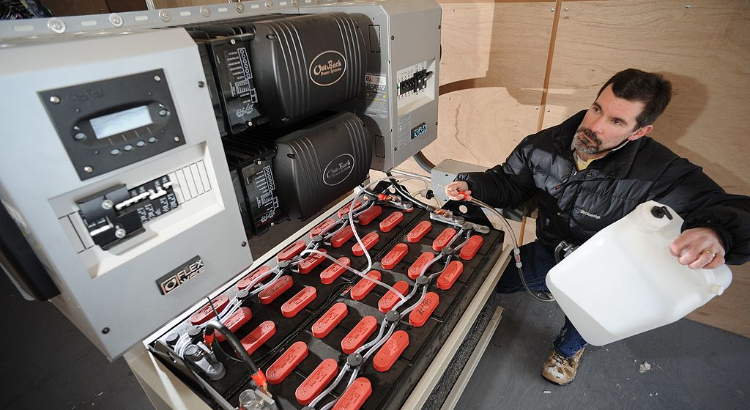This is one of five major green building trends we’ve identified for 2019. To explore more of them, see our Five green building trends for 2019 cover story.
Over the last decade, the cost of photovoltaic cells plummeted while their efficiency skyrocketed. That drove an unprecedented boom in solar farms and rooftop installations.
Now, it’s batteries’ turn.
To be sure, the battery and energy storage industry faces big challenges. Price, performance, capacity and a limited supply of key materials still raise questions about scalabilty. Most experts agree that current technologies for batteries, fuel cells and other energy storage products lack the capacity it would take to build a 100 percent renewable-energy grid at anything approaching a realistic cost.
But venture capitalists are funding efforts to find long-term solutions in a big way. The prospective technologies range from salt-water batteries to compressed-air cells to ingenuous schemes that are too complicated to get into here. The biggest single chunk of private money is coming from Breakthrough Energy Ventures, a billion-dollar fund backed by Bill Gates, Michael Bloomberg, Jeff Bezos and Jack Maa among others. Breakthrough’s top investment objective: “incredibly cheap grid-scale storage with a very long calendar life.”
Meanwhile, incremental advances have rendered existing technologies less expensive and more efficient. In an echo of the solar market, the cost of lithium-ion batteries has dropped by 80 percent over the last 10 years, according to one estimate.
“We’re starting to get pricing … for next year that is shocking even to us how low it is,” the CEO of one leading installer of solar arrays bundled with batteries said in a late 2018 interview.
The result: More solar-plus-storage was installed worldwide in 2018 than in any previous year. Forecasters say the U.S. market is particularly set for spectacular growth in 2019. Ravi Manghani of Wood Mackenzie Power & Renewables projects that American installers will deploy around 1.6 gigawatt hours of energy storage this year — more than double the 2018 total.
The surge is expected partly because, until now, demand was pent up by a lack of standards and limitations typical in rapidly changing markets. But in December 2018 grid operators met a federal deadline to file plans to accommodate energy storage; that’s giving manufacturers a better idea of the standards they need to meet. Meanwhile, over the last two years, battery plant openings have dramatically increased manufacturing capacity. And some states are finally adjusting their clean energy incentives to make storage eligible.
Another reason for the anticipated growth: Owners, engineers and contractors increasingly view storage as a standard for renewable energy installations — whether at the residential, commercial or utility scale. By Manghani’s measure, solar-plus-storage now competes with the least expensive electricity generated by fossil fuels.
Mechanical engineer Marc Brune of PAE Engineers in Portland, Oregon, notes that affordable energy storage can change the calculus for both individual projects and the global power infrastructure. While building-scale storage allows rooftop solar arrays to supply electricity even when they’re not producing power, utility-scale energy storage is “a big part of helping the grid accept a large amount of renewable energy.”
PHOTO AT TOP: Researcher tests solar energy batters at the Center for Advanced Energy Studies. Photo courtesy Idaho National Laboratory.
The Kendeda Living Building Chronicle reports on regenerative design and construction, which a special focus on the Kendeda Building for Innovative Design and Construction. To explore more of our Five Green Building Trends for 2019, click here.


